Welcome to the 2021 edition of Quill & Pad’s early Grand Prix d’Horlogerie de Genève predictions in which the team picks favorites and explains why.
The panelists are:
Elizabeth Doerr (ED), co-founder and editor-in-chief
Ian Skellern (IS), co-founder and technical director
Joshua Munchow (JM), resident nerd writer
GaryG (GG), resident collector
Martin Green (MG), resident gentleman
In the Tourbillon category we find men’s mechanical watches comprising at least one tourbillon. Additional indications and/or complications are admissible.
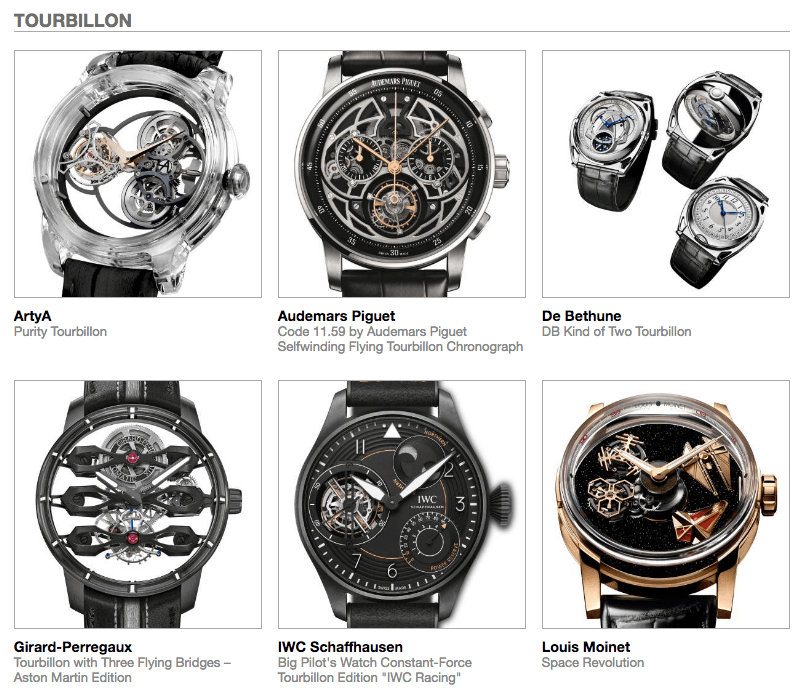
Nominated Tourbillon category watches in the 2021 GPHG
JM: When it comes to the Tourbillon category, any semantics over what counts as a complication or how useful a tourbillon actually is for increasing accuracy goes out the window. This category is simply about highlighting awesome tourbillons and the watches they are found in.
In that sense, this can be like the Artistic Crafts category in how the pieces appeal to one’s own taste or style; they don’t need to compete on a technical level. The rules say nothing about any criteria aside from having at least one tourbillon and that other complications are allowed. So we end up with a handful of very cool and different watches that all share one main thing in common: that classic tourbillon.
ED: What a diverse bunch of tourbillons! Two of them are beautifully transparent, while one of them is combined with a chronograph. Yet another contains a constant-force device, while one example here can be flipped around. And, finally, the sixth is involved in a space war. And each one is a very worthy contender that could – and even should – take the prize home here. How to choose?
IS: Unlike a few of the GPHG categories we have already covered, the Tourbillon category looks relatively homogeneous in that they are all fairly normal watches with tourbillons so are easier to compare. But that’s not to say that there aren’t some real standouts here (there are a few), and one in particular makes this an easy pick for me.
MG: Will the tourbillon ever go out of fashion? I think that the opposite is even more true. The market is now moving into a direction in which brands get even more creative, and that is something to applaud!
Artya Purity Tourbillon
IS: I’m not normally a fan of ArtyA as the brand’s watches are usually just too wacky for my tastes, but the Purity Tourbillon has got me reappraising my opinion. At 46 mm in diameter, I wish the case was smaller and more wearable on more wrists, but for those with the size (and wallets) to pull this watch off it is a stunner.
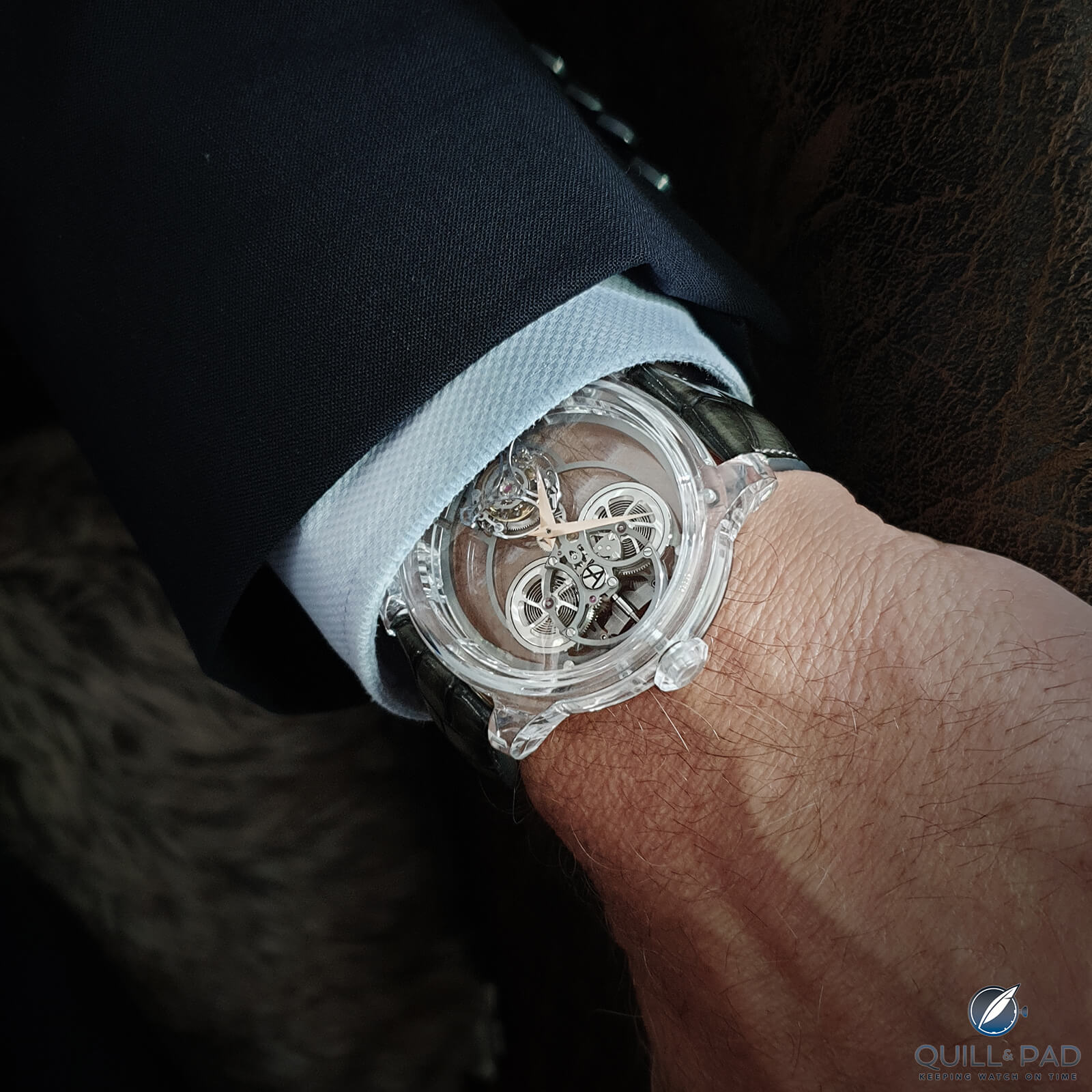
ArtyA Purity Tourbillon on the wrist
Most sapphire crystal-cased watches allow a view into the movement, but the Purity Tourbillon has an ethereal movement specifically designed to make the most of the incredible transparency. The movement isn’t overpowering: you can see and appreciate each component and mechanism fully without being overwhelmed by everything else. It’s my pick for second place and I think it will be a strong contender.
MG: Artya usually takes things over the top, but in this case the brand is right on point, Ian. That’s probably also why the brand called this watch Purity. While I’m normally not a huge fan of sapphire crystal cases, it works very nicely in this one with the beautifully laid out and skeletonized movement. The sapphire crystal also helps keep the watch’s weight down as 46 mm is a monstrous size, taking away much of the magic of the watch.
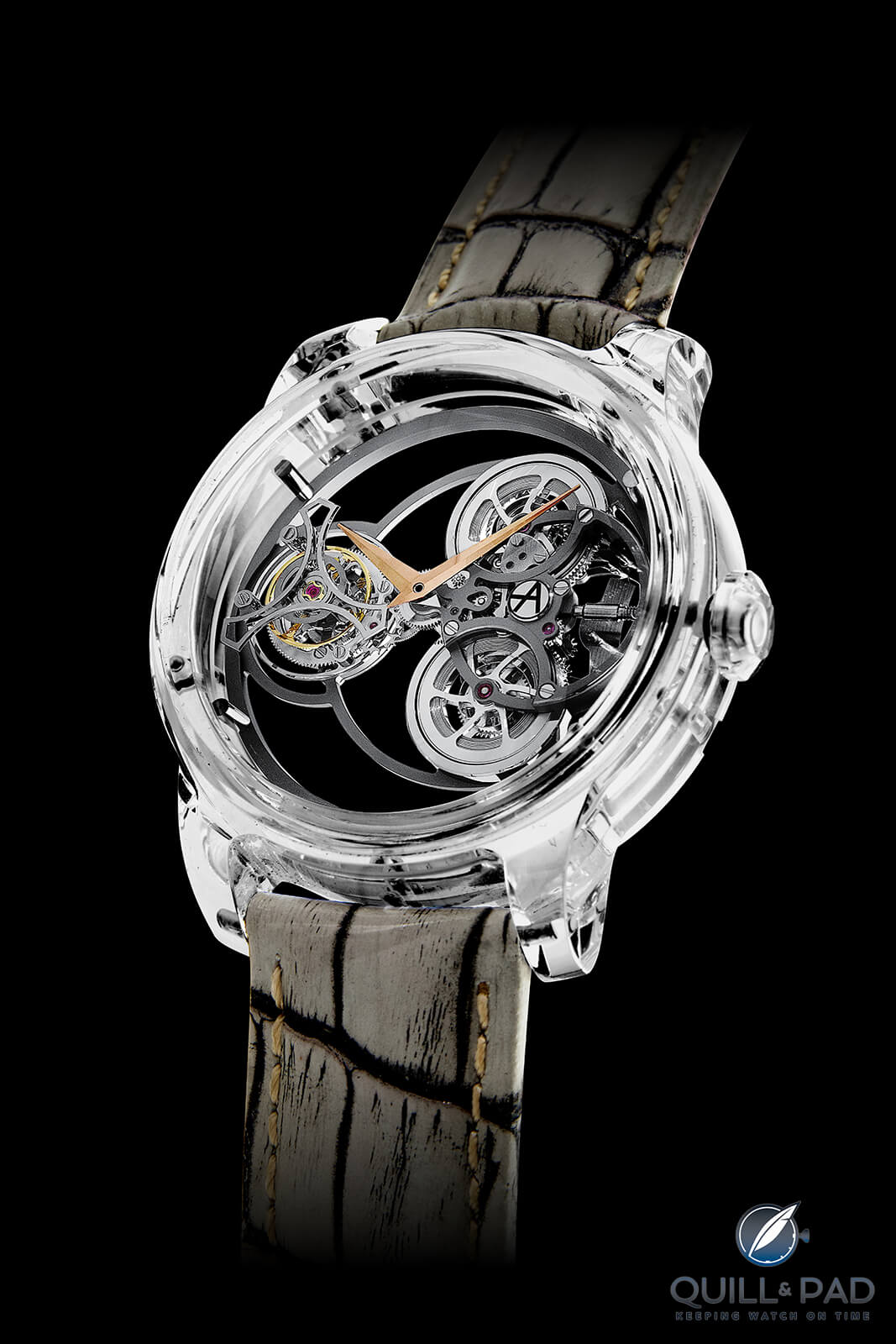
ArtyA Purity Tourbillon
ED: It also helps keep the visual weight down, Martin. I saw this watch in the metal, and I can tell you it does not wear as big as its actual size. I became an instant fan once I saw it and only wish it wasn’t up against some of the other watches in this category as this clever timepiece deserves some real recognition!
GG: ArtyA isn’t a brand that I think of that often, but I like the Purity Tourbillon: it’s avant-garde in line with the brand’s personality, but in ways that engage our curiosity using simple forms and open skeleton work consistent with the “purity” theme. No zooming spaceships on this one (see below)!
JM: I recently covered this piece and really enjoyed spending time with it considering all its details. I enjoy the movement architecture, the simplicity of the case, and the inclusion of a flying tourbillon, which is clearly great. But do I think this represents something special or unique in regard to the tourbillon? Not really. Do I think it stands out enough to win the category given the competitors? No, not this year.
Further reading: ArtyA Purity Tourbillon: Science Fiction Turned Science Fact
Quick Facts Artya Purity Tourbillon
Case: 46 x 12.5 mm, sapphire crystal
Movement: manually wound caliber with one-minute flying tourbillon with free-sprung balance with variable inertia, twin spring barrels, 4 Hz/28,800 vph frequency, 70-hour power reserve
Functions: hours, minutes
Limitation: 13 pieces
Price: 120,000 Swiss francs
Audemars Piguet Code 11.59 Selfwinding Flying Tourbillon Chronograph
GG: Audemars Piguet seems finally to be figuring out how to fill the massive Code 11.59 case with movements and displays that provide a sense of substance rather than emptiness. The Selfwinding Flying Tourbillon Chronograph has plenty to entertain the eye, but for me the ornate bridges visible on the front of the watch seem to some extent a solution in search of a problem, and the tourbillon and subdials are crowded way too close to the center of the dial, a pet peeve of mine that suggests the movement is too small for the case.
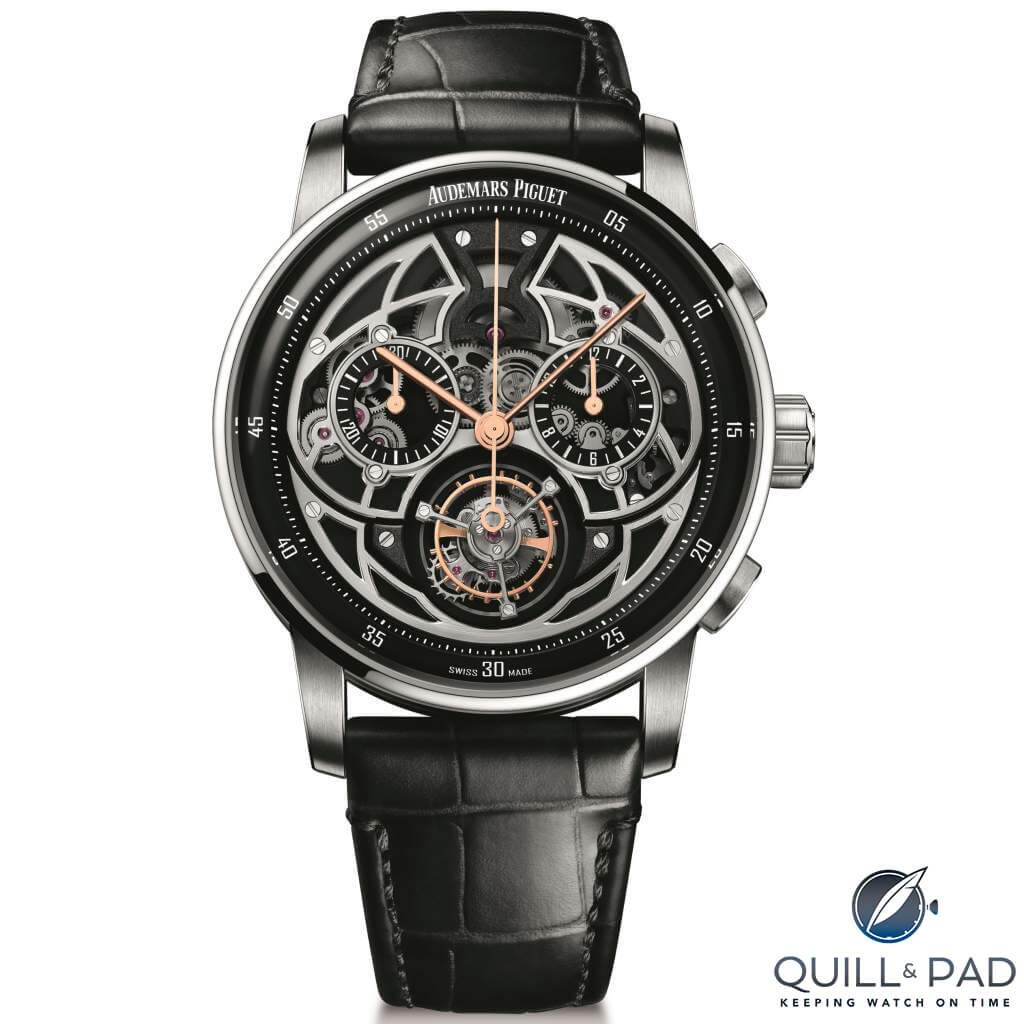
Audemars Piguet Code 11.59 Selfwinding Flying Tourbillon Chronograph
ED: I agree with Gary that this dial is filled out well for a Code 11.59. I feel like the brand could be hitting its stride with that new line. Even if the dial is a bit messy while remaining interesting.
Choosing pink gold to help keep the timekeeping elements more visible was clever – the watch needed it.
MG: I do not really know what to think of this 11.59, Elizabeth. What happened to the brand that could make such stunning dress watches as the Jules Audemars and Edward Piguet? I find the hands too small, but perhaps that is also because they are so overpowered by the fuzz on the dial with the skeletonized top bridges. This a pet peeve of mine, Gary: when you charge a quarter of a million for a watch, at least put in the effort to number it individually and don’t just put “limited edition of 50 pieces” on the back.
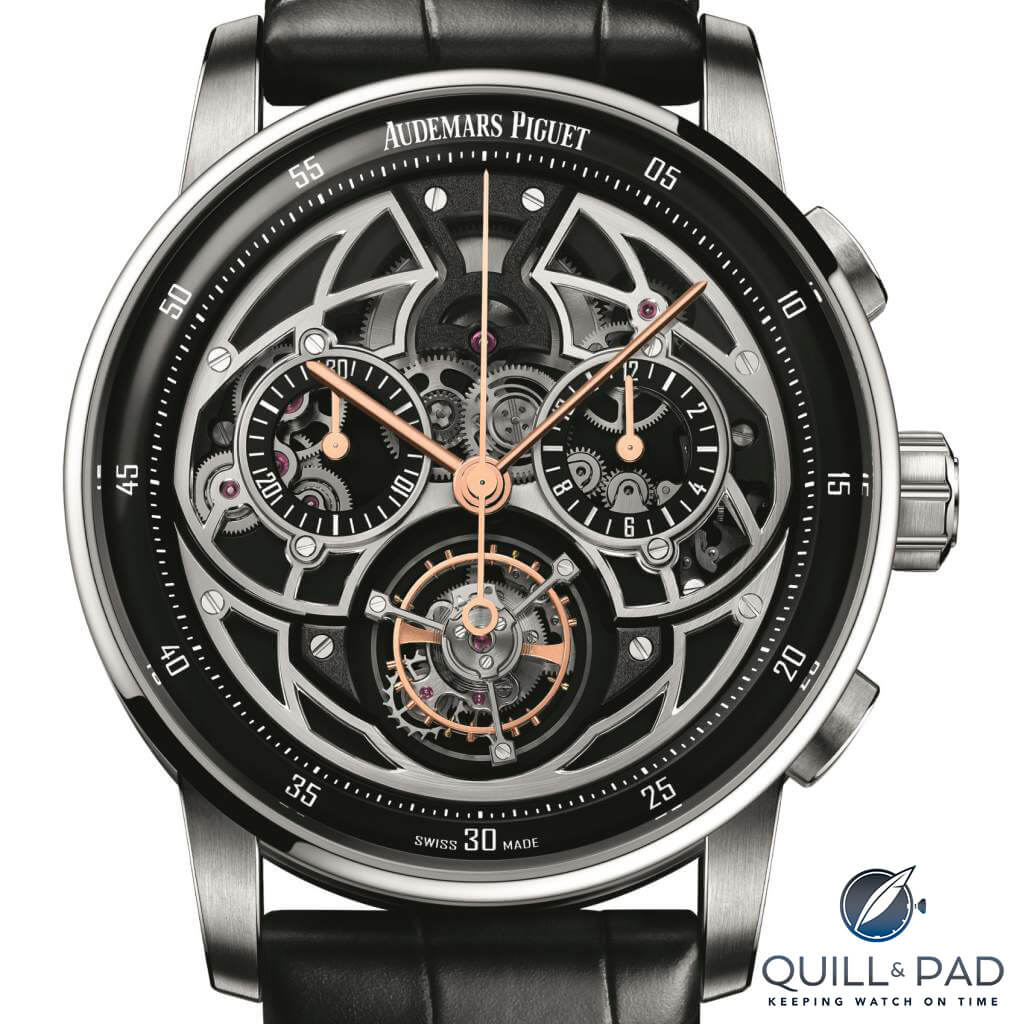
Audemars Piguet Code 11.59 Selfwinding Flying Tourbillon Chronograph
JM: This piece has an amazing looking movement with awesome details not to mention it’s a flyback chronograph with a tourbillon, firmly putting it in the upper levels of modern watchmaking. But like with many Code 11.59 pieces, the aesthetics are hit or miss, and this is a great example of where less could have been more.
I can’t say I’m a fan of what appears to be superfluous dial skeletonizing and slightly dull design choices for the subdials. I think this watch is something that is functionally amazing but loses it when it comes to looks and presentation.
IS: The skeletonized dial of this Audemars Piguet Code 11.59 Selfwinding Flying Tourbillon Chronograph makes it look too busy for me, but what saves it are those pink gold hands (and tourbillon cage), which make the indications legible. While a tourbillon and flyback chronograph make this a complicated watch, the price of 266,300 Swiss francs just seems exorbitant to me.
Audemars Piguet is on a roll as far as sales go and it’s looking like the brand is milking that for all it’s worth. It will be interesting to see if the markets will accept that or if the high prices will end up biting them in the butt.
Quick Facts Audemars Piguet Code 11.59 Selfwinding Flying Tourbillon Chronograph
Case: 41 x 13.7 mm, white gold
Movement: automatic Caliber 2952 with one-minute flying tourbillon, 65-hour power reserve, 3 Hz/21,600 vph frequency
Functions: hours, minutes; flyback chronograph
Limitation: 50 pieces
Price: 266,300 Swiss francs
De Bethune DB Kind of Two
GG: I for one found it quite easy to choose my winner in this category as the De Bethune DB Kind of Two Tourbillon is a technical and aesthetic tour de force. In addition to the obvious flipping case, there are many other clever elements to this piece, not the least being the use of a tourbillon-based small second indication on the contemporary side of the watch and a lovely, big sweeping central second hand on the traditional side. Other touches include the re-shaping of the familiar deltoid-shaped bridge to be fully symmetrical, at once telling us that this watch is a De Bethune and that it is also not just a rehash of earlier designs. A winner, start to finish.
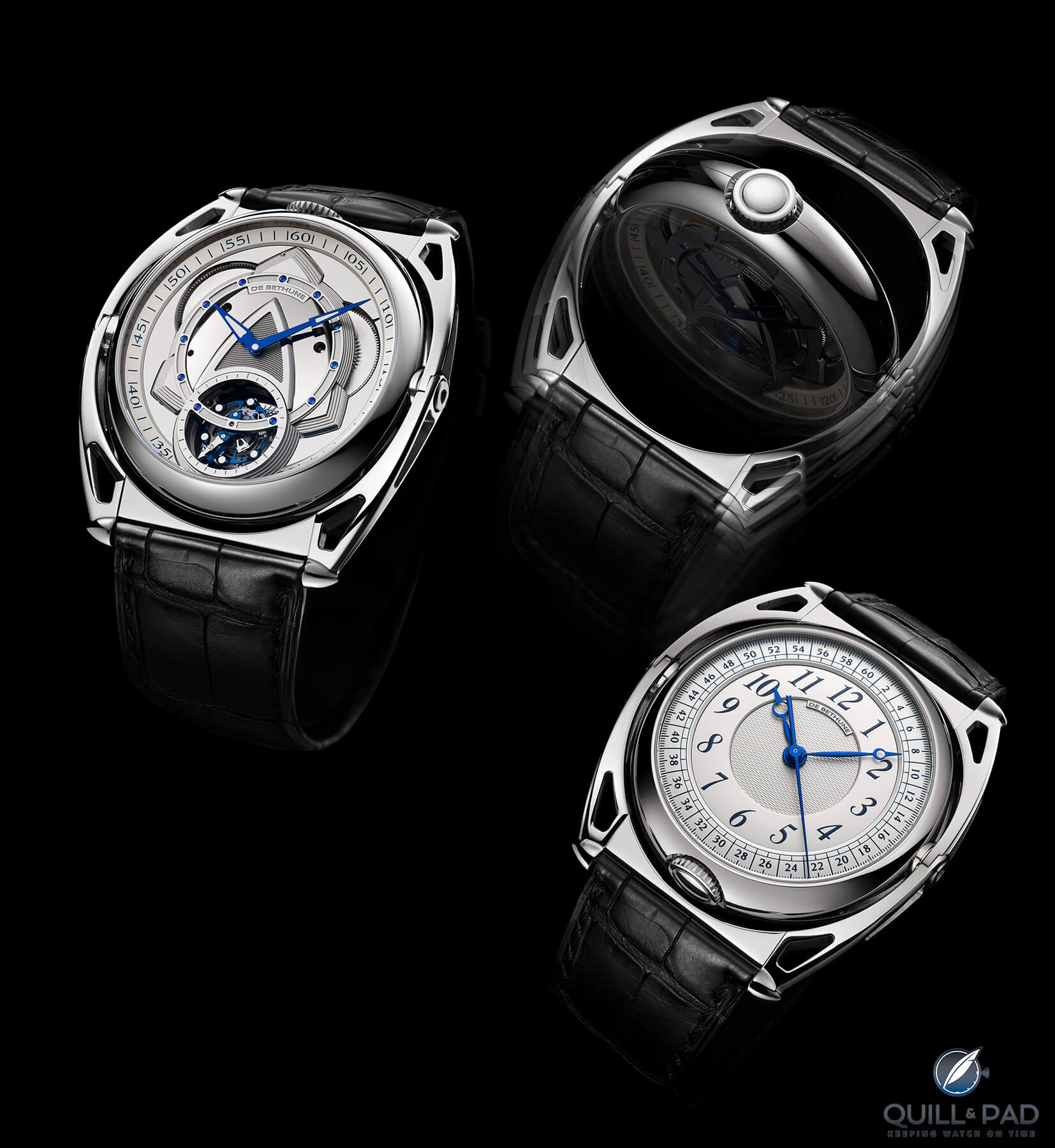
The two dials and case rotation of the De Bethune DB Kind of Two Tourbillon
JM: It is hard for me to ever find something wrong with a De Bethune watch, and the DB Kind Of Two Tourbillon is no exception. In fact, this is more De Bethune than many models because it features elements from the DB25, DB27, DB28, and DB29 – and it all flows together perfectly.
The biggest feature is the easily flippable case that allows the wearer to choose either the front or rear, each of which has a time display with unique aesthetic. Of course, it also has a De Bethune tourbillon, which is unique as well. If the jury goes the independent route, I can’t see any other watch deserving to win: it’s my pick for sure.
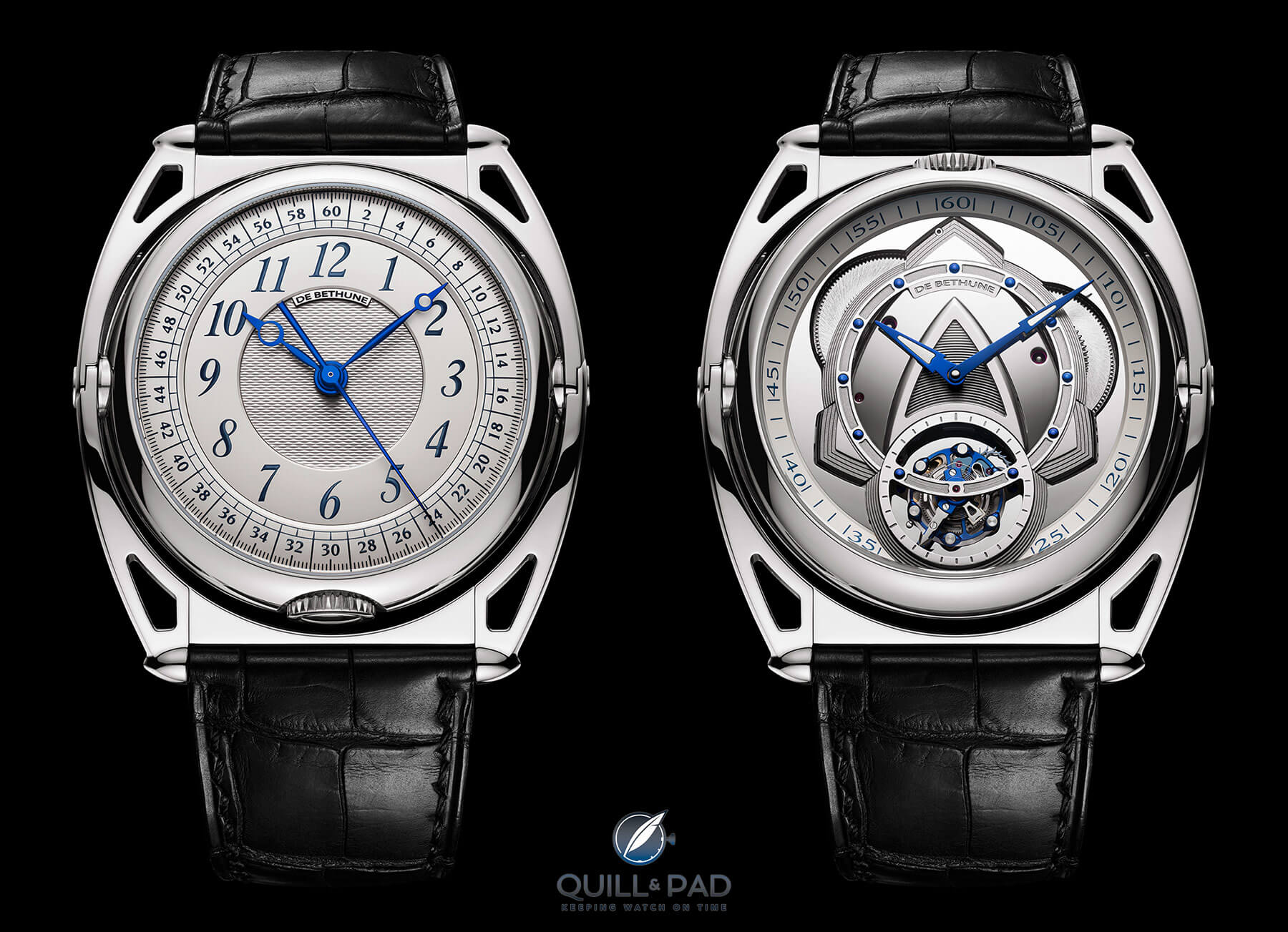
One watch, two faces: De Bethune DB Kind of Two Tourbillon
IS: I love De Bethune’s eye-catching, space-age dials, but there are times when the occasion calls for something tamer and less obtrusive. Until now, that meant having two different watches. But the Kind of Two Tourbillon gives you two very different looking watches in one. A five-day power reserve with a 30-second tourbillon is impressive, but even more so is the less than ten-millimeter thickness. A 43 mm case would normally be on the big side for my small wrists, but I can attest to the fact that De Bethune’s wrist-wrapping floating lugs are an absolute dream to wear, even on smaller wrists.
The De Bethune DB Kind of Two Tourbillon is my runaway pick to win the 2021 GPHG Tourbillon category.
MG: Is this the best, and most beautiful watch De Bethune ever made? I believe so! It is so elegant, so much fun, while packing a serious horological punch. I also love it that they went for titanium, a favorite of the brand, which they polished to perfection. This makes it comfortable and light, but also offers that play of light that this material in a polished state does so well. The fact that you get two watches in one, representing both sides (no pun intended) of the De Bethune universe makes for perfection. My winner in this category.
ED: I love how this watch allows the wearer to express different moods – even if the science-fiction-like De Bethune side is my favorite. The idea and execution are just genius. My hands-down pick for winner here.
Further reading:
De Bethune DB Kind Of Two Tourbillon: Two Dials Means Double The Pleasure
De Bethune DB Kind Of Two Tourbillon: Double-Faced Split Personality With Floating Lugs (Video)
Quick Facts De Bethune DB Kind of Two Tourbillon
Case: reversible in grade five titanium, 42.8 x 9.5 mm; floating lugs, crown at 6/12 o’clock
Movement: manually wound Caliber DB2579 with 30-second tourbillon with titanium balance wheel and white gold inserts, silicon escape wheel, self-regulating twin spring barrels, silicon escape wheel, 5 Hz/36,000 vph frequency, five-day power reserve
Functions: dual hours, minutes; seconds on one side
Limitation: 10 pieces
Price: $250,000 / 215,000 Swiss francs
Girard-Perregaux Tourbillon with Three Flying Bridges Aston Martin Edition
MG: I am still looking for what makes this Girard-Perregaux so “Aston Martin.” If this is the beginning of the partnership it is not very promising as in essence we just get a Tourbillon with Three Flying Bridges with a different case that you could wear while driving an Aston Martin. Not that I believe many owners will because what you have to fork out for this watch brings you close to half of what you have to pay for a substantial part of Aston Martin’s collection.
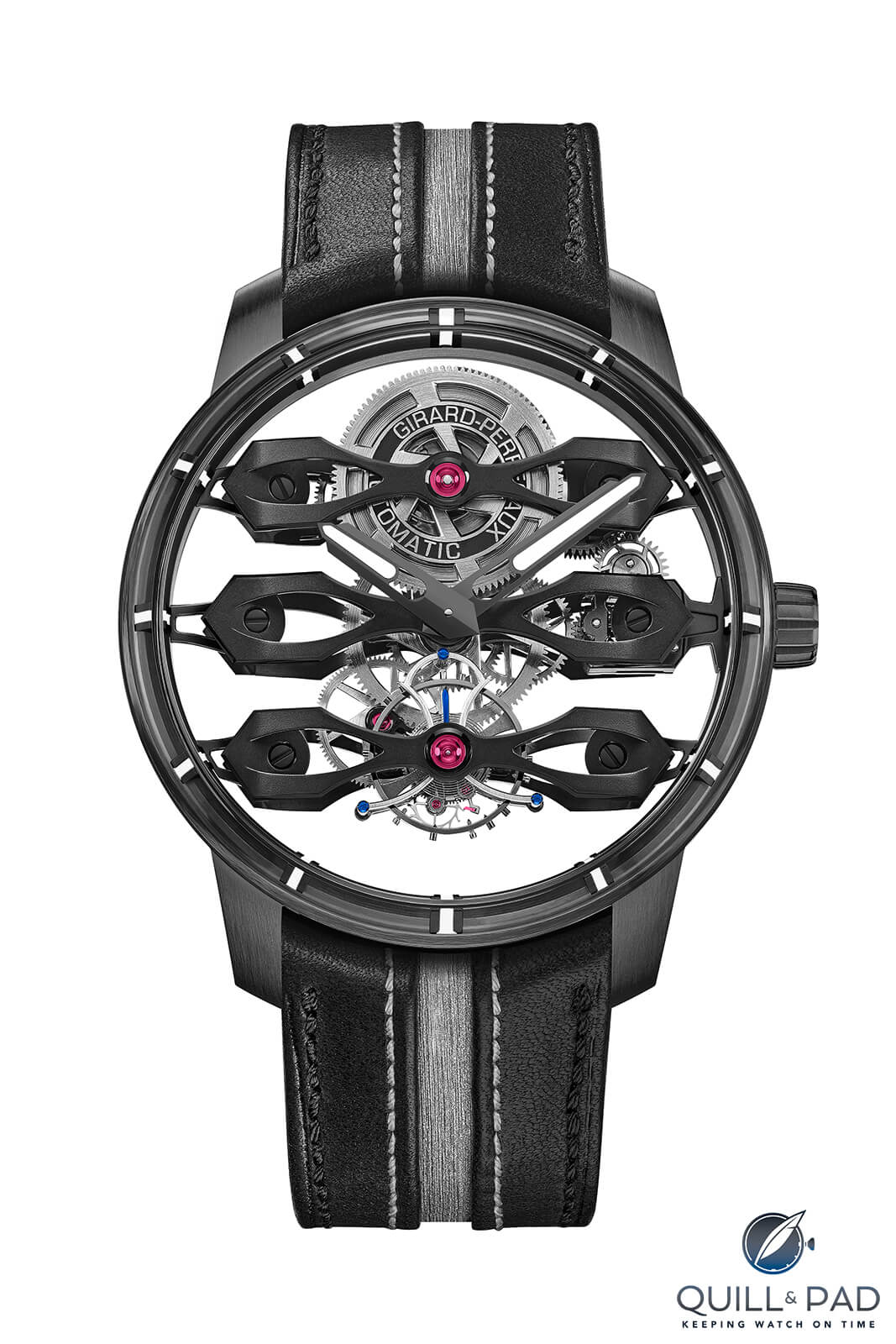
Girard-Perregaux Tourbillon with Three Flying Bridges Aston Martin
ED: Martin, it’s the participation of the Aston Martin design team under Marek Reichman – which I will agree is not as visible here as I might have liked with the exception of the very cool strap, which comprises black calfskin with Girard-Perregaux Rubber Alloy, a rubber insert injected with white gold. The result is really beautiful. Girard-Perregaux says that the design of this strap is intended to evoke historical Aston Martin racing cars, and I do think that that is achieved.
What a shame Girard-Perregaux did not enter the pink gold variation of this tourbillon, which is somehow so different that it blew me away at Geneva Watch Days 2021. I like this black “Aston Martin” edition but I like the pink gold edition far more.
IS: I prefer the pink gold version as well, Elizabeth.
JM: This is a stunning watch with awesome movement and crazy architecture. It also is, in my mind, a fantastic mix of the most classic Girard-Perregaux features with modern aesthetics. And this might just be its downfall. I know a lot of people love the Three Bridges from GP, and making it modern and avant-garde has definitely had mixed reception among purists. Of course, I have no concerns, but I do think that could cause this piece to lose the crown considering the other entries in this category.
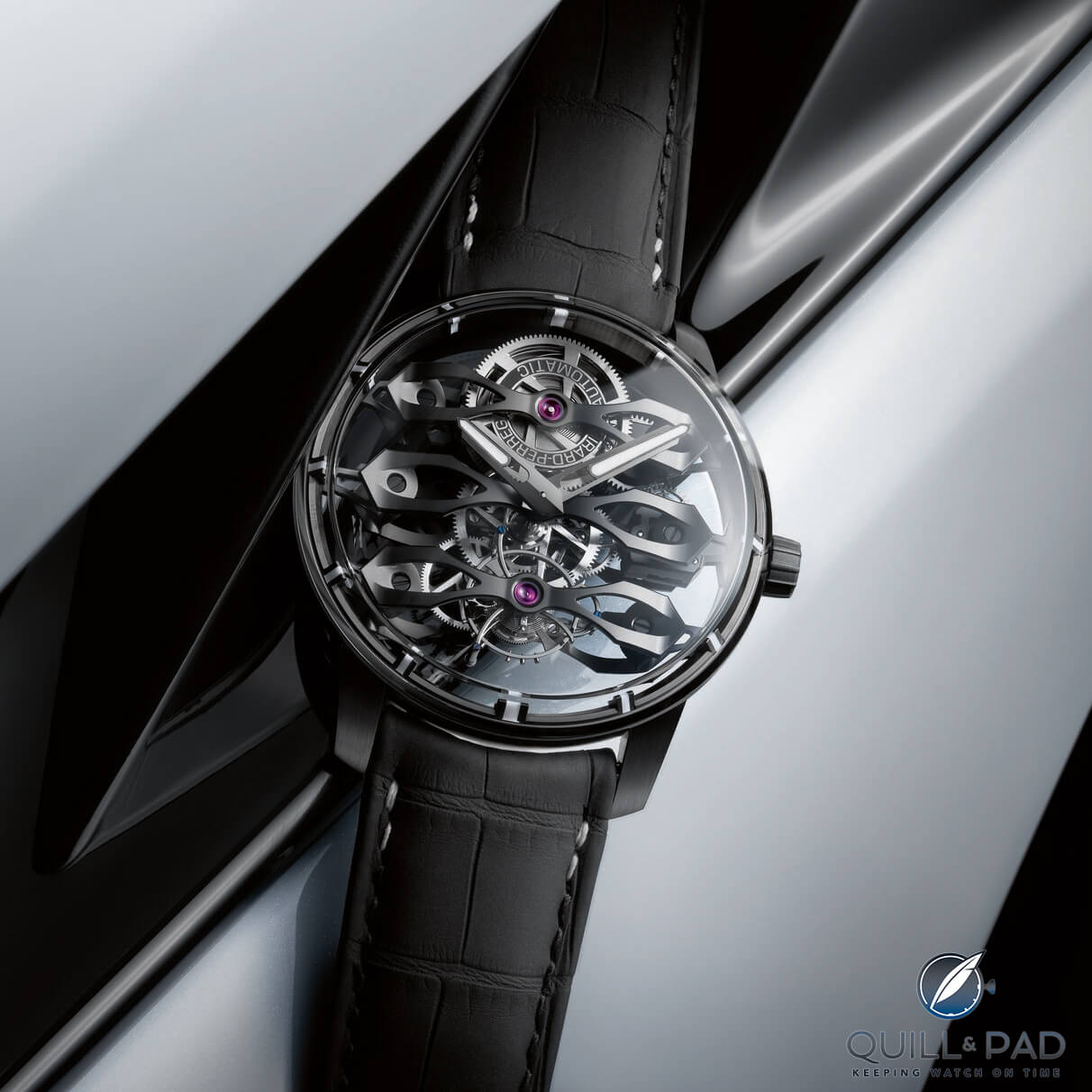
Girard-Perregaux Tourbillon with Three Flying Bridges Aston Martin
IS: Black looks to be a predominant color (or non-color) of this tourbillon category, but the Girard-Perregaux Tourbillon with Three Flying Bridges Aston Martin pulls it off best because the transparent movement largely disappears behind those three iconic black bridges. This Aston Martin edition is a striking watch and extremely well executed, but it’s too derivative rather than innovative for me to pick it as a strong contender here (which will probably guarantee that it wins.)
GG: The Girard-Perregaux Aston Martin Edition is, like the Artya, a watch that majors in openness and minimalism. In the case of the Girard-Perregaux, the now-familiar bridges are rendered “flying” with the use of spidery end elements that link each bridge to the case. And while the box crystals might be a bit too thick on the wrist, I am sure that they provide a dramatic view of the suspended movement.
ED: Ah, I did not find this particular one too thick at all, Gary, when I tried it on during Geneva Watch Days. I was actually surprised at how thin it looked on the wrist.
Further reading: Girard-Perregaux Tourbillon With Three Flying Bridges: An Icon Zooms In The Partnership With Aston Martin
Quick Facts Girard-Perregaux Tourbillon with Three Flying Bridges Aston Martin Edition
Case: 44 x 15.52 mm, DLC-coated grade 5 titanium
Movement: automatic Caliber GP09400-1683 with one-minute tourbillon, 60-hour power reserve, 21,600 vph/3 Hz frequency
Functions: hours, minutes, seconds on tourbillon
Limitation: 18 pieces
Price: $146,000 / 139,000 Swiss francs
IWC Big Pilot’s Watch Constant-Force Tourbillon Edition “IWC Racing”
MG: Now, this is a Big Pilot! I always like how the brand puts complications into this model as it utilizes the space so well. I will forgo the whole race car driver wearing a Big Pilot, though, as 46.2 mm simply doesn’t work in that context. However, the Big Pilot is a very attractive watch showing that a complicated escapement like the constant-force tourbillon can also be perfectly incorporated into a more modern design.
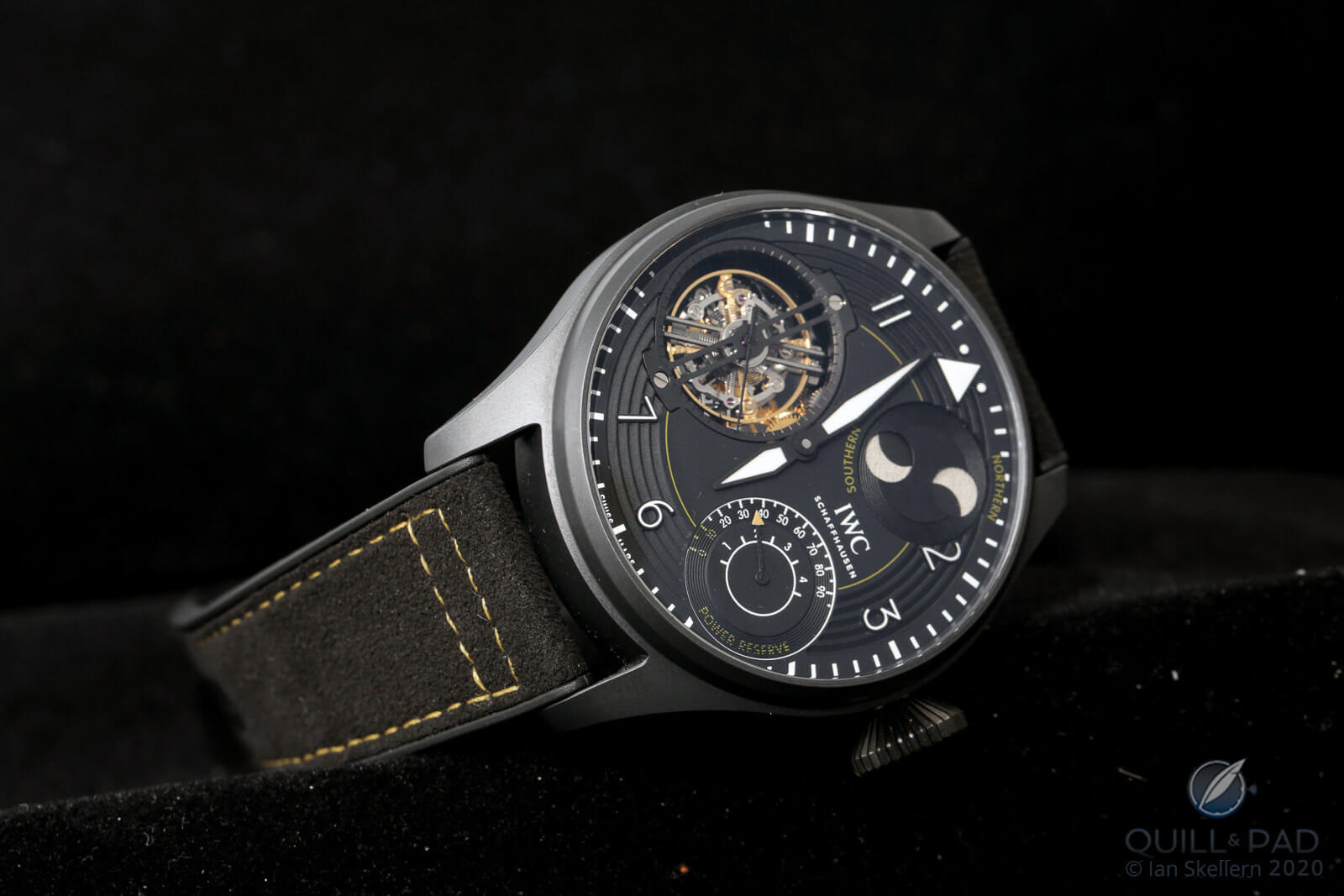
IWC Big Pilot’s Watch Constant-Force Tourbillon Edition “IWC Racing”
IS: I could copy/paste my comments about the black Girard-Perregaux Tourbillon with Three Flying Bridges here and replace the name with IWC Schaffhausen Big Pilot’s Watch Constant-Force Tourbillon Edition “IWC Racing.” It’s a great looking watch, I like the constant force movement, and the tourbillon is a nice touch, but (as I said above), “. . . it’s too derivative (the model was launched in 2019) rather than innovative for me to pick it as a strong contender here (which will probably guarantee that it wins).”
JM: This is a very close runner-up for me if the jury votes for the independents in any measurable way. But if the jury leans heavy into established bigger brands, I could see this piece leading to an upset. The constant force tourbillon with moon phase and power reserve makes this one very capable watch that looks technical while remaining relatively low key considering exactly what is inside. I wouldn’t be surprised if it snuck in there under De Bethune’s nose to take the prize, but I feel it might be a little too subdued to take the win. It’s a very technical watch, which is awesome, but sometimes people want a little pizazz, and this piece is aesthetically safe.
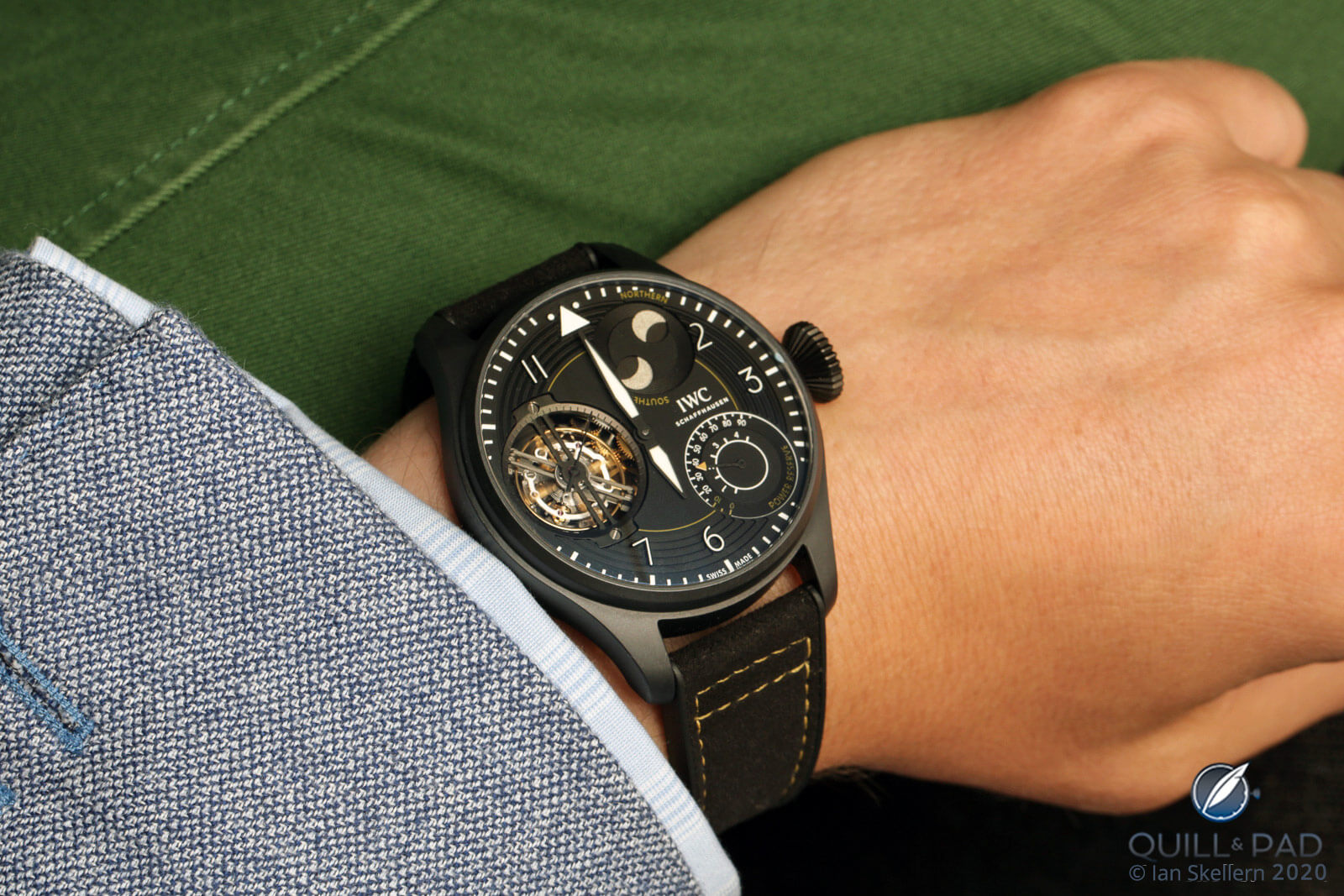
IWC Big Pilot’s Watch Constant-Force Tourbillon Edition “IWC Racing” on the wrist
ED: Putting this highly complex movement in such a sporty watch is a pretty clever way to get the new generation interested in high watchmaking. Nonetheless, it does seem derivative given that we’ve seen this movement for many years now.
GG: Constant force mechanisms are most useful in maintaining consistent timekeeping when the mainspring nears the end of its effective reserve, reducing the torque it is able to provide to the movement. So why do so many recent watches with fancy constant force gizmos shut off partway through the power reserve cycle? The latest example: the IWC Schaffhausen “IWC Racing” watch in this category, with a listed power reserve of 96 hours but a constant force arrangement that operates only for the first 48 hours of that period.
Further reading: IWC Big Pilot’s Watch Constant-Force Tourbillon Edition “IWC Racing”: Haute Horlogerie Constraints
Quick Facts IWC Big Pilot’s Watch Constant-Force Tourbillon Edition “IWC Racing”
Case: 46.2 x 13.5 mm, Ceratanium (ceramized titanium)
Movement: manually wound Caliber 94800 with one-minute tourbillon, 96 hours power reserve, 18,000 vph/2.5 Hz frequency with variable inertia balance and constant force escapement
Functions: hours, minutes, seconds; power reserve, dual-hemisphere moon phase
Limitation: 15 pieces
Price: 220,000 Swiss francs
Louis Moinet Space Revolution
ED: I really like what Louis Moinet does, and this watch is no exception: this little space-war microcosm featuring two tourbillons, each orbiting the dial in opposite directions and each carrying a titanium spaceship on its “tail,” is a truly fascinating proposition. The spaceships and tourbillons are placed on different levels, crossing each other 18 times an hour and looking for all the world like they are partaking in an epic space battle. This is pure entertainment on a high horological level!

Louis Moinet Space Revolution
GG: The Louis Moinet Space Revolution with its two tourbillons rotating in different directions at different speeds and crossing each other 18 times per hour is certainly an impressive technical feat to be commended for its ingenuity. Aesthetically, the watch is faithful to its outer space theme, and I suspect that there are enough rich space nerds out there to buy up the eight-piece limited edition.
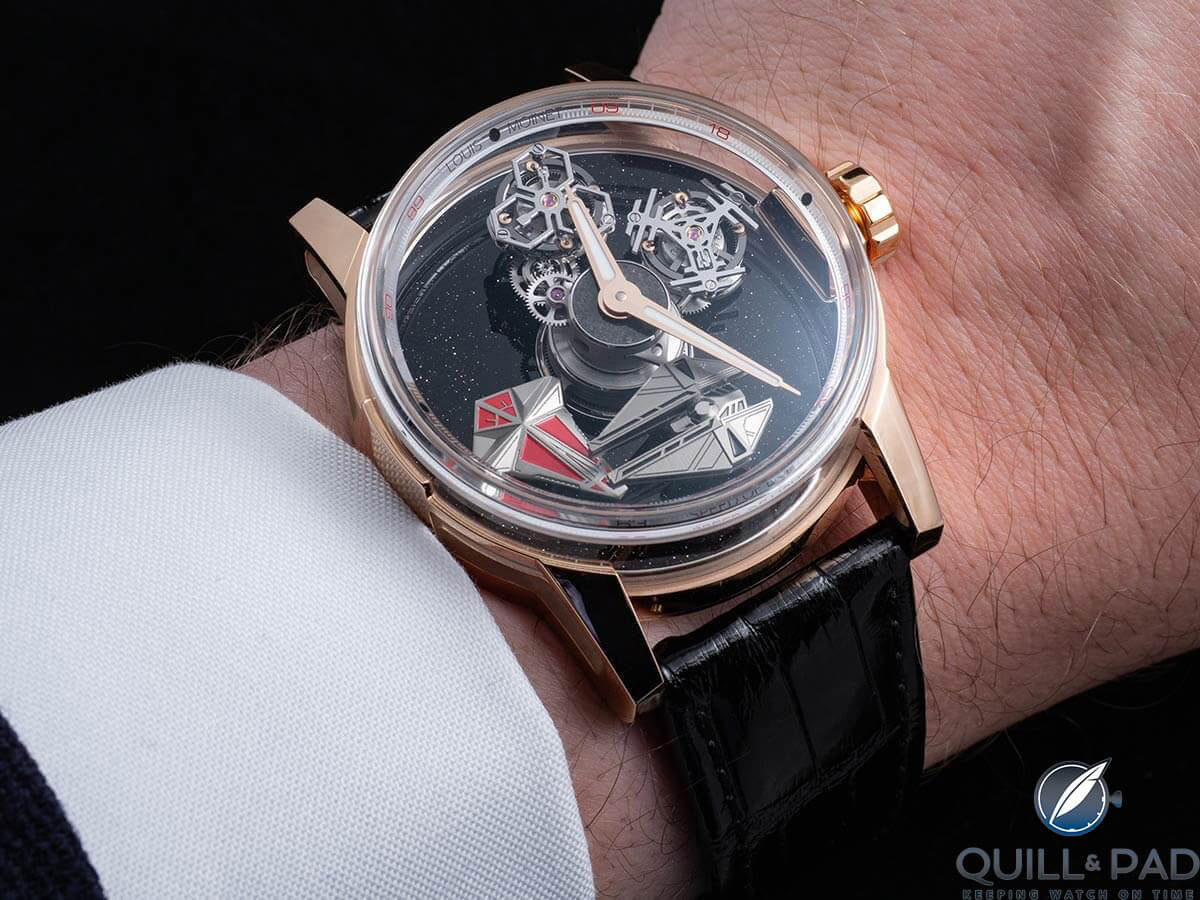
Louis Moinet Space Revolution on the wrist
MG: This is a fun watch. Perhaps that is also its downside, as the two tourbillons and spaceships turn around on the dial, but there is no further contribution to chronometric excellence. While this does result in a watch that never looks the same when you check the time, it is a playful evolution but not an important revolution in my book.
ED: This extreme space-themed dial animation is one of the most action-packed, playful horological “shows” I have ever seen; it is pure science fiction theater underscored by rare space souvenirs in the form of meteorite fragments coming from the moon, Mars, and even the oldest known rock in the solar system. And the lucky owners can choose from eight different fragments, making their watches unique. That’s a pretty uncommon idea in my book.
JM: The Space Revolution is quite possibly the wildest tourbillon to be seen in the GPHG in a long time and one of my favorite creations from Louis Moinet in a half decade. It clearly plays with sci-fi imagery in creating two spaceships that counterbalance two tourbillons rotating around the dial in opposite directions, one in five minutes, the other in ten minutes.
Each tourbillon has a different bridge shape, and the entire satellite assembly is backed by black aventurine for an epic simulated view of space. I truly love the creativity of this piece, but I also fear that is what could put it out of the running for the prize. It is way “out of bounds” for classic watchmaking.
ED: It’s the “outer limits,” right, Joshua? To me, it seems to extend what classic watchmaking is capable of. But like you, I’m not sure everyone is ready for this just yet.
JM: For a category built upon the tourbillon, one of the most classic and historically significant mechanisms, this piece feels too forward looking. I am certain people will have a lot of fun with it, but I fear it is just too atypical to take the prize here.
IS: With its two counterrotating tourbillons, the Louis Moinet Space Revolution certainly has the technical chops to do well here. But I can’t help but feel that I’m looking at a Star Wars-themed video game. I’m sure it will have many sci-fi fans, but the design is likely too neoteric to find its audience in the jury.
Further reading: Louis Moinet Space Revolution: An Epic Space Battle On The Wrist (With Video)
Quick Facts Louis Moinet Space Revolution
Case: 43.5 x 18.3 mm, pink gold
Dial: black aventurine
Movement: hand-wound Louis Moinet Caliber LM 104 with two separate one-minute tourbillons, 21,600 vph/3 Hz frequency, 48-hour power reserve, twin mainspring barrels
Functions: hours, minutes; spaceship animation, crown function selector on back (winding and time setting)
Limitation: 8 pieces, each with a unique meteorite in the center
Price: 360,000 Swiss francs
Predicted winners
Elizabeth: De Bethune DB Kind of Two Tourbillon
Ian: De Bethune DB Kind of Two Tourbillon
Gary: De Bethune DB Kind of Two Tourbillon
Martin: De Bethune DB Kind of Two Tourbillon
Joshua: De Bethune DB Kind of Two Tourbillon
You may also enjoy:
Leave a Reply
Want to join the discussion?Feel free to contribute!





















































The De Bethune is the hands down winner in my book.
Regarding the AP Code 11.59, isn’t a watch at its most basic supposed to be legible? This dial is a successful study in camouflage!